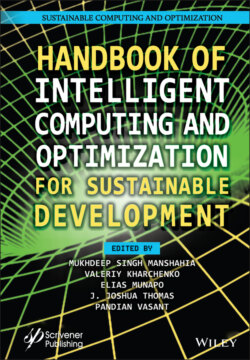Читать книгу Handbook of Intelligent Computing and Optimization for Sustainable Development - Группа авторов - Страница 117
5.1 Introduction
ОглавлениеRecent advancement in computing systems has led to proliferation in use of machine learning (ML) and deep learning (DL) algorithms. These are used to solve the classification, estimation, and optimization problems for wireless systems which include modulation classification, signal detection, channel estimation, and resource allocation (RA) to name a few [1, 2]. Even though the ML is extensively applied in various application areas, its use in communications systems is still uncultivated [1, 3–5]. DL is the subset of ML paradigm. The key effect of applying the DL in the communications systems has been computational complexity issues and availability of benchmark data sets [6, 7]. DL typically consists of two stages named as training and testing. In the first stage, a huge data is passed through DL networks to generate a trained model, and training stage always runs with billions of computations. In the testing phase, data set other than the training data set is offered to the network model to deduce a outcome, and this stage needs to conclude in a desired time period [8, 9]. In practical implementation of real communications systems only the testing phase is applied. The training phase is usually completed offline. A trained DL model can thus achieve multiple objectives without the need for retraining [10, 11].
With the increased demand for higher data rate services supporting multimedia, video, voice, and Internet of Things (IoT) application over wired and wireless links, new model-driven signal processing algorithms provide feasible solution to massive connectivity. These techniques should possess capability to provide high data rate at permissible Quality of Service (QoS), with ultra-reliable low latency (URLL) [12]. To meet the above requirements, future wireless network use ML algorithms as one of the key solutions. Artificial intelligence (AI)/ML algorithm potentially can provide intelligent future networks along with desired URLL [13, 14]. In wireless systems, a ML-based algorithm can be applied at the transmitter side, either to enhance the performance of single block or jointly at transmitter and receiver to develop an intelligent wireless system. Most of the present (4G) and future wireless systems (5G) are employed with orthogonal frequency division multiplexing (OFDM) in conjunction with massive multi-input multi-output (MIMO) technology to provide desired service standards [9, 15, 14]. The advancement of intelligent terminals and promising new applications (e.g., real-time and communicating services), wireless communication data traffic has radically enhanced, and existing wireless systems (even an upcoming 5G) cannot entirely meet the quickly rising technological requirements [13, 16, 17]. To meet these upcoming challenges, the beyond 5G (B5G) or sixth-generation (6G) wireless network is anticipated to explore the novel radio spectrum standards and energy-efficient transmission techniques along with intelligent wireless networks [2, 18].
To address the future upcoming challenges, a comprehensive review of existing literature has been performed in this chapter. Further, case studies on automatic modulation classification (AMC) and channel state information (CSI) feedback for frequency division duplexing (FDD) massive MIMO system has been carried out using novel DL techniques. The simulation results for the proposed method for AMC shows up to 10% improvement in the prediction accuracy compared to the existing baseline model [19]. In case of CSI feedback in massive MIMO, implementation results using the proposed algorithm have shown superior recovery of the channel matrix with cosine similarity of around 5% and the reduction in normalized mean square error (NMSE) is approximately 2 dB for different compression ratios in comparison to the baseline network [20].
Following the introduction, the organization of the chapter is as follows: Section 5.2 provides a comprehensive review of ML and DL techniques for future wireless communication system. Section 5.3 provides the two case studies based on our present work. Section 5.4 presents the major findings of the overall study. Section 5.5 discusses the future direction in field of ML-enabled next-generation wireless communication. Finally, Section 5.6 concludes this chapter.
